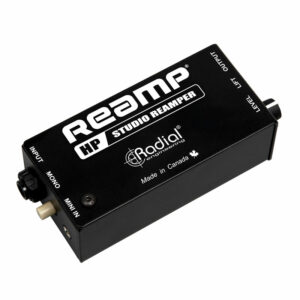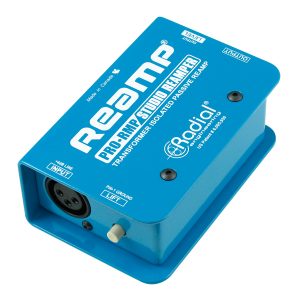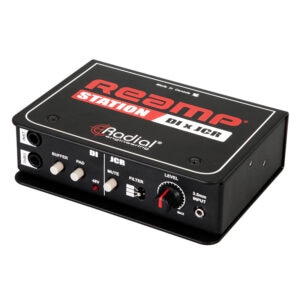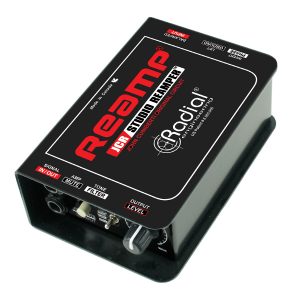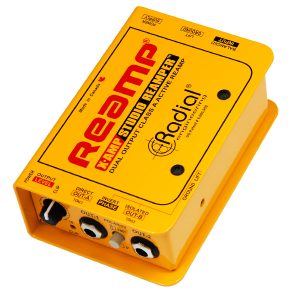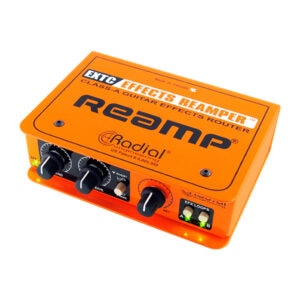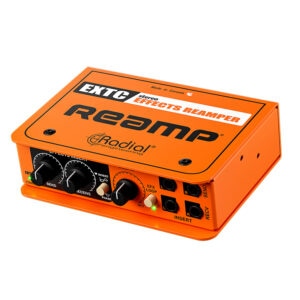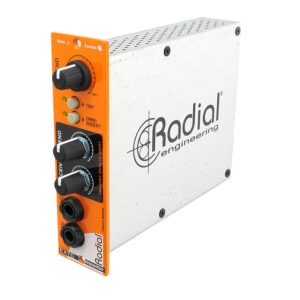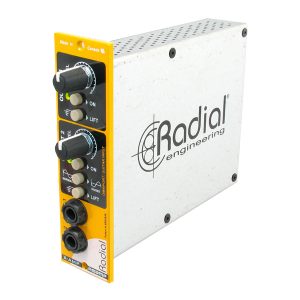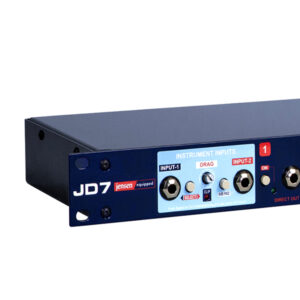What’s the right Reamper for you?
Choosing the right Reamper for your studio can depend on a number of factors, from your budget to your preferred workflow, and the choice you make can have a big impact how you incorporate Reamping into your music. Here we’ll look at and compare the various Reampers available. If Reamping is a new concept for you, or should you simply need a refresher, be sure to check out our Reamp® Academy page for an all-encompassing introduction.
Getting started with Reamping
Reamping is a studio recording technique that involves taking a recorded audio track (usually guitar or bass) and playing it back through a guitar amplifier, then capturing the results by recording the output of the amp to a new track. Since devices like audio interfaces aren’t designed to be connected directly to guitar pedals or amplifiers, a Reamp® box is required in order to convert the signal strength and impedance in order to maintain the integrity of your audio signal and give you the best possible sound quality. For an in depth intro to Reamping, check out our Reamp® Basics page.
Here is a look at two excellent entry-level Reampers that are perfect for anyone who is just getting started with using Reamping in their studio.
ProRMP
Studio Reamper
The Radial ProRMP is a compact passive Reamper, meaning it doesn’t require any power to operate. It uses a transformer to manage the audio conversion, which also helps greatly reduce the chance of running into hum and buzz from ground loops when connecting your amp to the output of your recording interface. A ground lift helps further reduce ground loop noise, and an adjustable level control allows you to dial in the right amount of signal for your amp. The ProRMP is also popular for a unique application on stage – improving the sound of wireless guitar systems. Wireless receivers can have a harsh effect on the tone when connecting their output to pedalboards and amplifiers, but connecting the ProRMP between these devices helps correct for impedance and level mismatches and improves the sound quality immediately.
Reamp® HP
Compact Reamper
The Reamp® HP takes a different tactic than most Reampers do in terms of the sound source. Typically, a Reamp® device connects to a balanced line-level output on an audio interface or a console, but these outputs can be in short supply if you use a smaller interface in your studio. Many devices will just have two balanced outputs, and these will likely be connected to a pair of studio monitors. Instead of having to unplug one of your monitors every time you have the inspiration to Reamp®, you can instead reach for the Reamp® HP. This Reamper is designed to connect to the headphone output on your interface, so you don’t have to repatch any equipment to get started. You can use 1⁄4” or 3.5mm mini headphone jacks, depending on what’s available, and it even allows you to Reamp® using a smartphone or tablet as your audio source.
Upgrade your Studio
For those with more recording experience with Reampers, Radial offers multiple devices covering a range of specs, features, and color to fit particular set ups. We recorded a video comparing four of our original Reampers to help display the tonal differences. Watch the video below and be sure to listen to the accompanying audio playlist as well.
X-Amp
Active Reamp®
The Radial X-Amp in a class-A active Reamper, which gives it a slightly different tonal character than a passive interface. We often compare this difference to condenser vs. dynamic microphones – both get the job done and sound great, but many engineers will have their preference of one over the other for certain applications. The benefit that the X-Amp gains by being an active Reamper is that you have a second amp output so you can drive two amplifiers simultaneously, making it twice as efficient to layer multiple tracks for full, lush guitar tones.
JCR
Studio Reamper
The Radial Reamp® JCR is a passive Reamper that uses the original circuit designed by industry legend John Cuniberti, which has found its way into countless recording studios around the world. The JCR includes a custom wound USA-made transformer which is featured in the design to preserve as much detail and clarity of the original track as possible. This Reamper also includes a few other handy features that can make it easy to incorporate into your studio and improve your workflow. Both XLR and 1⁄4” TRS inputs are available, so you don’t need to reach for an adaptor cable to connect it to your audio interface, and a three-position filter switch allows you to compensate for overly bright or dark amplifiers. One last helpful feature is the humble mute switch, which has saved countless eardrums by giving the engineer a way to cut sound to the amplifier while they are right next to it adjusting mic placement.
Reamp® Station
Studio Reamper & Direct Box
Compact Reamper
The Reamp® Station combines two studio essentials in one chassis: an active DI box for pristine recordings of any instrument, and the JCR high-performance Reamper to feed those recordings to your guitar amps and pedals during mixdown. The crucial first step to Reamping is recording your original track – this forms the basis for your Reamped tone later on, so it’s important to capture the sound of the instrument with as much detail as possible (and as little noise and interference). Using a high quality direct box is key to this first step, and the Reamp® Station makes it easy since you won’t have to reach for a different device for each step of the Reamping process. Once you’ve recorded your instrument cleanly with the DI side of the Station, you can immediately get to Reamping with the on-board JCR Reamper. This includes all of the features mentioned above with original JCR, but also includes the ability to connect mobile devices to the 3.5mm input, or daisy-chain multiple Reampers together to feed more than one amp from a single output on your interface.
Reamp® Effect Pedals
Reamping can also be a great way to utilize your full pedal collection when recording. Whether you are adding your favourite distortion on a guitar track, or revitalizing a forgotten phazer pedal to liven a drum track, Reamping with effects pedals unlocks new creative possibilities in the studio. We have a “Reamping Effects Pedals” blog and video to help get you started…
EXTC-SA
Guitar Effects Interface
The Radial EXTC-SA is a stand-alone audio interface that lets you incorporate guitar effects into the realm of pro-audio recording. This does the job of your typical Reamper, by taking a feed from your audio interface and converting the signal so it can be connected directly to guitar pedals. However, unlike other Reampers, it also converts the signal after you pedals so you can feed them right back into your audio interface for recording. This eliminates the need to have your pedals connected to an amplifier with a mic on it, and opens up your pedalboard collection for use on any prerecorded track. Vocals, drums, strings, horns… all of them can be sent through your pedals just as you would any outboard studio processor. The EXTC-SA has send and receive level controls to optimize your gain staging for the lowest possible noise, and a Blend control that gives you the ability to choose how much of the effect is added to the signal for parallel processing. The great thing about the EXTC-SA is that you can also use it for standard Reamping sessions as well, so you will have all your pedals and amplifiers at your disposal during your next mixing session.
EXTC-Stereo
Stereo Guitar Effects Interface & Reamper
The EXTC-Stereo takes the concept one step further, and adds a second channel so you can now incorporate stereo effects pedals and devices for Reamping. You can also feed your amplifiers as mentioned above, so it makes it easy to Reamp® through stereo pedals into a dual amp setup, while maintaining a true stereo signal throughout.
500 Series and other Devices
Reamp® devices come in multiple forms in order to accommodate various recording setups, including 500 series and rack mount options.
EXTC 500
Guitar Effects Interface
The Radial EXTC 500 takes the same principle as the EXTC-SA and puts it into a compact 500 series format. As mentioned above, this gives you the power to use any pedal as if it were an outboard effects processor, so your pedal collection can be put to use on any track in your mix.
X-Amp 500
Reamper
The Radial X-Amp 500 puts a high quality Reamp® device in the 500 series format. Just like the X-Amp, it features class-A circuitry for studio quality sound and it allows you to connect to two amplifiers simultaneously.
JD7
Guitar Distro & Splitter
The Radial JD7 Injector is a rackmount guitar distribution center, that can drive up to seven amps or pedal chains simultaneously. This makes it great for those with multiple amplifiers in the studio who want to turn them on without having to repatch cables each time. A Reamp® input on the rear panels allows you to connect your audio interface to the JD7 for playback through all of your amps, making it perfect for auditioning a track through multiple amp types in a short amount of time.
Hopefully this overview has given you a better idea of which Reamp® box is the best option for your studio. If you have further questions or would like assistance in selecting the right Reamper for your particular setup, please feel free to reach out to us via our FAQ form, we would be happy to hear from you.

